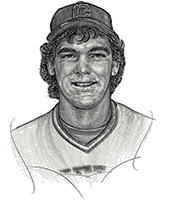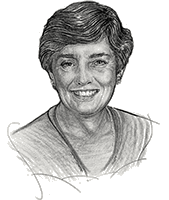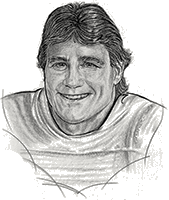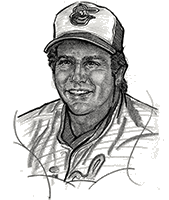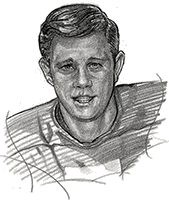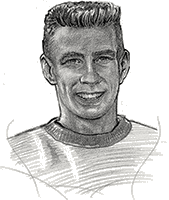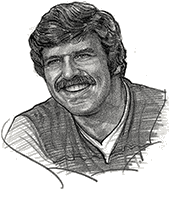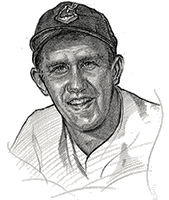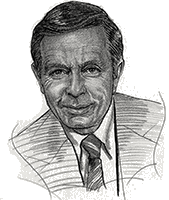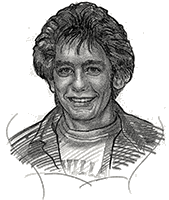Just as Camelot provided the inhabitants of King Arthur’s court with “one brief shining moment,” Charboneau would do the same for long-suffering Cleveland Indians fans some 14 centuries later. The carefree native of Belvidere, IL, burst upon an unsuspecting major league scene in 1980, two years after being traded to the Indians by the Philadelphia Phillies in a minor league deal. With spring training injuries opening the door, he found himself in the Tribe’s starting lineup on April 11 and proceeded to hit-and hit-and hit. By season’s end he had built a .289 batting average with 23 home runs and 87 runs batted in and found he had been named the American League’s “Rookie of the Year.” But there were other sides to the irrepressible rookie’s talents which kept the town buzzing, the turnstiles humming and inspired the inexplicably popular song hit “Go Joe Charboneau” which soared to #3 on the local charts. Such as his penchant for dying his hair grotesquely unnatural colors, opening beer bottles with his eye socket and drinking the beer through his nose with a straw, doing his own dental work and reportedly resetting a broken nose with a pair of pliers. It was enough to terrorize every mother of an impressionable youngster, but somehow to know him was to love him. It all came to a crashing end (literally) the following spring when he hurt his back in a headfirst slide during an exhibition game. He was never the same. He underwent two back surgeries, played in 60 more major league games and was released in 1983. But the mutual love affair with Cleveland prompted him to continue making his home in the area while staying active in various baseball-related activities and he now makes his home in North Ridgeville.
A dominant competitive figure on the Greater Cleveland golf scene for a remarkable span of nearly 40 years, she was still hitting ’em down the fairways in quest of more titles at the time of her induction into the Greater Cleveland Sports Hall of Fame. Her collection of trophies at that point reflected nine Greater Cleveland Women’s Golf Association championships between 1969 and 2004 and seven runner-up finished, two titles and a pair of second place finishes in the Women’s Ohio State Golf Association Senior Championships, one title, one medalist and four semi-finalist finishes in the Women’s Ohio State Golf Association Championships and a myriad of other titles or significant finishes in tournaments not only in Ohio, but also on a national level as well as in her earlier years in her native state of Pennsylvania. Small wonder that the Northern Ohio PGA designated her a “Legend of Golf” in 2003. A retired teacher who graduated from Ursuline College, and taught at elementary, high school and college level, she was a co-founder, along with her daughter, Anne Caja, an All-American golfer at William and Mary College, of the Ohio Girls Golf Foundation in 1994, a organization which has been instrumental in fostering the growth of the girls golf in Greater Cleveland schools by providing golf training programs, financial assistance to compete in golf tournaments and in providing college scholarships. She lives in Chagrin Falls.
What was earning first team all-ACC honors as a middle linebacker at the University of Virginia worth to Dick Ambrose? Selection in the 12th round of the 1975 NFL draft by the Cleveland Browns. What was Dick Ambrose worth to the Cleveland Browns for the next nine seasons? Priceless. The 6-0 235-pounder—who earned the nickname “Bam Bam” which he carried through his career when he broke a pair of shoulder pads while making a tackle in his rookie season—became a starter early on and retained that status, starting 64 consecutive games, until a broken leg sidelined him in the sixth game of the 1983 season. He led the team in tackles for five consecutive years from 1977 to 1981, was named the team’s most valuable defensive player in 1977, was an integral part of the storied “Kardiac Kids” in 1980 (a team which wrote a special page in the Browns’ history), was voted the winner of the Browns’ Captains Award made annually to “a team player and an inspiration” in 1981, and was elected a team co-captain in 1982. He began studying law while still an active player, and received his degree from Cleveland State’s Marshall College of Law in 1987 and practiced law in Cleveland until he was appointed a judge of the Cuyahoga County Court of Common Pleas in 2004. The native of New Rochelle, NY, has remained active in a large number of civic, charitable and athletic affairs in Greater Cleveland and makes his home in Westlake.
Raised in South Euclid, he became an all-state baseball pitcher at Brush High in 1965, then matriculated at Kent State where he teamed with catcher Thurman Munson to form what might have been the most impressive battery in Ohio collegiate history. Signed with the San Francisco Giants in 1969 and began his major league career with them in 1971. After two years with the Giants and six years split between the Chicago White Sox and Chicago Cubs, he was traded to Baltimore in 1979 and pitched for them in the World Series that year. He reached his zenith the following season, when he became the American League’s Cy Young Award winner after putting together a 25-7 record and pitching in the All-Star game. Turned to broadcasting after the 1981 season and was in his 18th season of doing the Chicago Cubs play-by-play on WGN-Radio at the time of his induction, teaming up with the legendary Harry Caray for the first 15 of those years.
One of Greater Cleveland’s top high school athletes in the early ’60s, he climaxed a brilliant football career by quarterbacking St. Joseph High to a 9-0-1 record as a senior in 1963 to earn a spot on the All-Ohio team as selection as the area’s outstanding scholastic by the Cleveland Touchdown Club. Moving on to Notre Dame, he played quarterback as a sophomore, then was converted to safety for his final two seasons. As a defensive player, he gained All-American as a senior when he set several school records that were to stand for more than 25 years, including most interceptions returned for touchdowns and most yards gained on punt returns in a game and a season. He was drafted by the Cleveland browns in 1968, but a stint in the Army put his professional career on hold until 1970 when he put in one season with the Browns. After several years in the business world, he returned to St. Joseph as an assistant football coach in 1988. He became the Vikings’ head coach in 1995 and added the duties of the athletic director in 1998.
Deceased 2023
Moved to Lakewood from Canada with his family at the age of 13 to carve a niche at Lakewood High School well up on the long list of first magnitude track stars who first shone on Greater Cleveland ovals, Gave notice of what lay ahead by winning the OHSSA state title in the 440-yd. dash as a sophomore in 1956 and defending his title as a junior, also finishing second in the 100 and 220-yd dashed that year. Then, as a senior in 1958, he turned in one of the most memorable performances in Ohio state meet annuals, winding up an undefeated scholastic career in the 440 by running the fastest schoolboy time (46.5 sec.) ever recorded in he U.S. and capturing the 100 and 220 titles to pace Lakewood to the state crown. As a collegian at Purdue, he set an American indoor record of 47.2 sec. in the 440 in 1960, won two Big Ten indoor 440 crowns and one outdoor championship, and ran for the United States’ 4 x American games. Became a teacher in the Dayton area after his track days and remained there in his retirement.
Inducted into the Pro Football Hall of Fame in 1999, he was born and raised in Cleveland, starred for the Cleveland Heights High football team, then went on to play for the University of Michigan’s 1964 Big Ten and 1965 Rose Bowl champions and to earn second team All-American recognition in 1965. A first round draft pick of the Los Angeles Rams in 1966, he played 13 seasons for the team at guard from 1966 to 1978, starting 176 of the 184 consecutive games he played, never missing a contest in his pro career. He was selected for 11 Pro Bowl games, a mark exceeded by only six players in NFL history, and to nine All-NFL first or second teams. Helped lead the Rams to eight division championships, including an NFL record six consecutive titles. Was team captain in his last four seasons. The son of Cleveland Indians second baseman and Case Tech football great Ray Mack, an early inductee into the GCSHofF, he became a vice president and regional executive for Bechtel Corp., the largest engineering and construction company in the United States, making his home in Las Vegas, NV.
Born and raised on Cleveland’s near East Side, he wrote an admirable story of perseverance as he scratched his way through nine noteworthy minor league baseball seasons in search of a cherished berth on his hometown team, the Cleveland Indians, only to be thwarted by a career ending injury with his goal in sight. Unable to play high school baseball, he signed with the Indians in 1953 and began a minor league odyssey that took him to the Green Bay Blue Jays, the Fargo-Moorhead Twins, the Keokuk Kernels, the Mobile Bears, the Reading Indians, on to San Diego, where he was to earn a spot in their Hall of Fame and Toronto (both then minor league franchises), Mobile, and Salt Lake City. En route, he was named to four league all-star teams, set an Eastern League record with 11 consecutive hits, and twice went to spring training with the Indians. The dream ended in 1961 with a collision between his shoulder and a wall during a second stint with Mobile. He returned to Cleveland, where he worked with Klein News until his retirement. A long-time resident of Seven Hills.
Earned a place for himself amongst Cleveland’s best-known sports writers during a career that spanned a remarkable 50 years, twenty-four of them as the beat writer for Cleveland Browns. During the lengthy career he covered many of America’s prime sporting events, including World Series, Kentucky Derbies, Super Bowls, Indy 500s, College All-Star Games, and the National Golf Opens. His Plain Dealer columns—Plain Talk, Extra Points, and Off the Cuff—were required reading for two generations of sports fans. He was the winner of the 1980 Pro Football Writers Association’s Dick McCann Memorial Award for Distinguished Reporting of Pro Football, and also was honored with the Cleveland Touchdown Club’s Meritorious Service Award in 1987, and the Society of Professional Journalists Distinguished Award in 1990. He retired in October 1993 and, at the time of his induction, was in his 41st year as a resident of Bay Village.
Deceased 2008
One of the best wrestlers ever developed on the Greater Cleveland area, he was a three time Ohio high school champion at Bay Village going 83-0 in his championship years (1974-6) and 104-5-1 for his scholastic career and earning first team high school All-American honors. At Bay he also earned two U.S. Wrestling Association National Freestyle titles. Continued his career at the University of Iowa where he was a four-time NCAA Division I All American, twice reaching the NCAA finals, and a four-time Big Ten Champion. After graduation he won National AAU Freestyle titles in 1983 and 1984 and was named second alternate to the 1984 U.S. Olympic freestyle wrestling team. Became the head wrestling coach at Edinboro University in 1984 and guided his team to five Top Ten NCAA finishes in six years, earning laurels as the NCAA Division II’s National Coach of the Year in 1986, then settled into a career in real estate, making his home in Westlake.
2001 Crocker Rd., Ste. 510, Westlake, OH 44145
Phone: 216-241-1919

